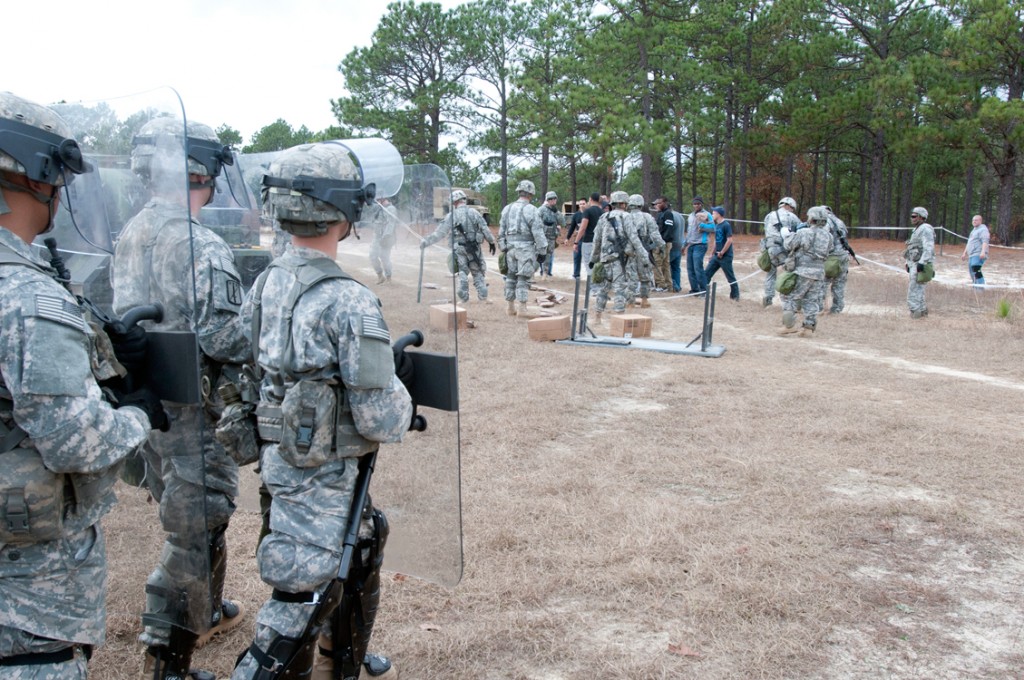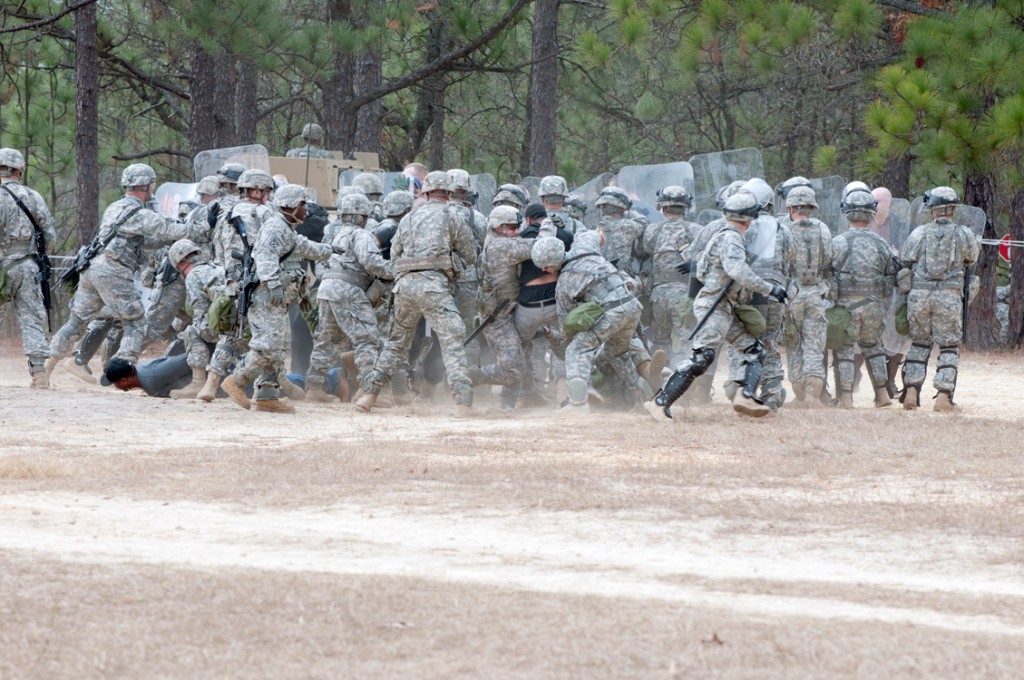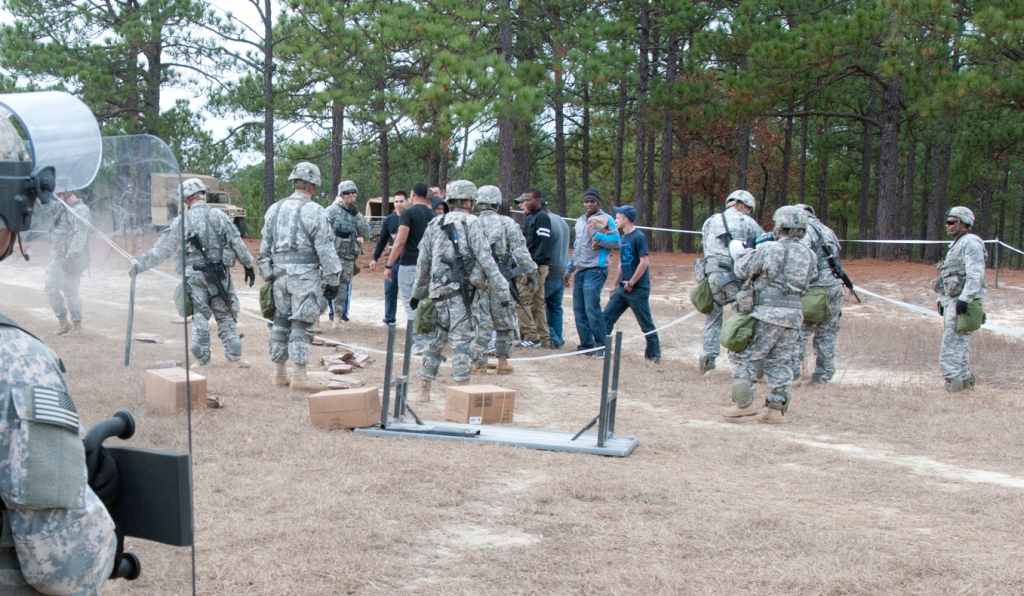The following photos depict members of the 3rd Battalion, 321st Field Artillery Regiment (3-321 FAR) training earlier this month in preparation for their deployment as a “quick reaction and rapid response force for U.S. Army North Command in support of emergencies in the United States.” An article from the 82nd Combat Aviation Brigade describes the exercise:
3-321 FAR trains to support US Army North
FORT BRAGG, N.C. — 82nd Airborne Division Soldiers trained to respond to a Category 5 hurricane in and around Simmons Army Airfield, Dec. 10 to 12.
The culminating training event was an opportunity for Troopers of 3rd Battalion, 321st Field Artillery Regiment, XVIII Fires Brigade, to prepare for their upcoming assignment as a quick reaction and rapid response force for U.S. Army North Command in support of emergencies in the United States.
“If the tasks over-exceed the capabilities of the civilian and local governments, U.S. Army North has the capability of deploying units to the continental United States to assist with everything from security operations and critical infrastructure to humanitarian assistance,” said Maj. Roy Beeson, the operations officer for 3-321 FAR.
The Thunderbolt battalion’s training centered on preparing to deploy by both ground and air, securing an airfield, establishing local security, responding to civil disturbances, reacting to a biochemical threat and conducting operational decontamination.
“Batteries A and B simulated a ground deployment, securing the aerial port of debarkation where humanitarian support supplies will fly into and establishing a humanitarian assistance site,” said 3-321 FAR Commander Lt. Col. Joe Bookard. “Battery C trained to deploy via air, conducting an initial joint technical inspection of vehicles and equipment to prepare them for the aircraft.”
After securing and establishing a humanitarian assistance site, the Bulldog Troopers of Battery B prepared to distribute food to a crowd of simulated U.S. hurricane victims. Sgt. Wesley Powell, an artillery section chief, helped search citizens for weapons using a metal detector before they entered the site to receive aid.
“I needed to ensure their safety and my own,” said the Cisco, Texas, native. “I want the civilians to have confidence in us and what we are trying to do for them. I was trying to talk to them and reassure them while I searched them, but I needed to make sure they didn’t have any weapons or things that could be used to harm other civilians or my unit.”
While distributing the food, some of the citizens became upset as they waited, and began to harass the unit and other hurricane victims, inciting a riot-like situation.
“This is a different mission set than what we’re used to – we’re artillery, so we’re ready to shoot rounds downrange. Now, we are training to provide assistance and security for U.S. citizens. We’re identifying how to deal with riot control and other disturbances,” said Capt. David Perez, Battery B commander.
“The ultimate goal is to ensure the safety of the local population and that humanitarian aid is being distributed in an orderly fashion.”

Denmark, S.C., native, Lt. Col. Joe Bookard, commander, 3rd Battalion, 321st Field Artillery Regiment, XVIII Fires Brigade, speaks to Troopers of Battery B, 3-321FAR, about their training after they responded to riot caused by unhappy simulated hurricane victims at a humanitarian assistance site outside Simmons Army Airfield, Dec. 11. Bookard and his Soldiers conducted a culminating training event to prepare the unit for its upcoming assignment as a quick reaction and rapid response force for the U.S. Army North Command in support of emergencies in the United States. (Photo by U.S. Army Staff Sgt. April Campbell, 82nd Combat Aviation Brigade Public Affairs)

During training, Troopers with Battery B, 3rd Battalion, 321st Field Artillery Regiment, XVIII Fires Brigade, prepare to respond to an escalating civil-disturbance situation caused by unhappy simulated hurricane victims at a humanitarian assistance site outside Simmons Army Airfield, Dec. 11. Riot-control was incorporated into the culminating training event for 3-321 FAR to prepare the unit for its upcoming assignment as a quick reaction and rapid response force for the U.S. Army North Command in support of emergencies in the United States. (Photo by U.S. Army Staff Sgt. April Campbell, 82nd Combat Aviation Brigade Public Affairs)

During training, Troopers with Battery B, 3rd Battalion, 321st Field Artillery Regiment, XVIII Fires Brigade, respond to riot caused by unhappy simulated hurricane victims at a humanitarian assistance site outside Simmons Army Airfield, Dec. 11. Riot-control was incorporated into the culminating training event for 3-321 FAR to prepare the unit for its upcoming assignment as a quick reaction and rapid response force for the U.S. Army North Command in support of emergencies in the United States. (Photo by U.S. Army Staff Sgt. April Campbell, 82nd Combat Aviation Brigade Public Affairs)

Sgt. Wesley Powell, of Cisco, Texas, uses a metal detector to search simulated hurricane victims at a humanitarian assistance site outside Simmons Army Airfield, Dec. 11. Powell and other Troopers with Battery B, 3rd Battalion, 321st Field Artillery Regiment, XVIII Fires Brigade, later reacted to a riot caused by some of the simulated hurricane victims. The culminating training event was an opportunity for Troopers with 3-321 FAR to prepare for their upcoming assignment as a quick reaction and rapid response force for the U.S. Army North Command in support of emergencies in the United States. (Photo by U.S. Army Staff Sgt. April Campbell, 82nd Combat Aviation Brigade Public Affairs)

